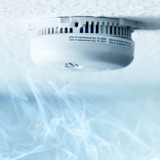Smoke Detectors 101
Most people realize the importance of having functional smoke detectors in their homes. Many know that if it beeps, it’s time to change the battery. Some may do a monthly test of the smoke detector. However, many people are unaware that there are different types of smoke detectors. Each type is designed to detect fires in different ways. The type of smoke detector you have could be the determining factor in the safety of your family should a fire occur inside your home.
Ionization Vs. Photoelectric
There are two main types of smoke detectors in most American homes. The most common type is referred to as an ionization smoke detector. In fact, it is more accurate to say it is a fire detector since it reacts mainly to the flames of a fire. While this is very useful, the problem occurs when slow, smoldering fires break out.
Characteristics of ionization smoke detectors include:
- Most common type, used in approximately ninety-five percent of homes
- Reacts most quickly to flames rather than smoke
- Takes anywhere from fifteen to thirty minutes longer to react to smoldering fires
Photoelectric Smoke Detector
The other type of smoke detector is referred to as a photoelectric smoke detector. This is found much more rarely in homes. This type of detector reacts more quickly to smoke. While this is good for small, slow burning fires, it often does not react as quickly to fast burning flames that produce less smoke.
Characteristics of photoelectric smoke detectors include:
- Found in only about five percent of homes
- Reacts more quickly to smoke but less quickly to fast burning fires
- May be more expensive than an ionization smoke detector
Most deaths are attributed to slow burning fires due to the fact that they usually occur at night when people are sleeping. They do not make much noise but they produce toxic smoke that can asphyxiate the people inside. By the time the ionization detector is activated, it could be too late.
If the fire is more aggressive, that can limit the time available for safe escape. It has been suggested that manufactures of ionization alarms, by far the most popular type, have known about the shortcomings of this type in detecting certain fires. Burn victims might consider seeking legal counsel if they feel they were not adequately warned by their smoke detector.
How to Protect Your Family
The best option for protecting your family from any fire is to install both types of alarms. While photoelectric alarms tend to be a bit more expensive that ionization alarms, the margin is not much and it is a very small investment to ensure the safety of your family. There are also companies that manufacture combination ionization/photoelectric alarms. Most experts agree that this is the best option in terms of safety.
Sources:
Taylor, Richard. “The Defect in Smoke Alarms.” Scribd. 10 Dec. 2010. Web. 15 Dec. 2014. <http://www.scribd.com/doc/34154792/The-Defect-in-Smoke-Alarms>.
“For the Best Protection, Use Both Types of Smoke Detectors.” For the Best Protection, Use Both Types of Smoke Detectors. Consumer Report News, 25 Mar. 2013. Web. 15 Dec. 2014. <http://www.consumerreports.org/cro/news/2013/03/for-the-best-protection-use-both-types-of-smoke-detectors/index.htm>.
“Ionization vs Photoelectric.” Ionization vs Photoelectric. 26 Feb. 2014. Web. 15 Dec. 2014. <http://www.nfpa.org/safety-information/for-consumers/fire-and-safety-equipment/smoke-alarms/ionization-vs-photoelectric>.














